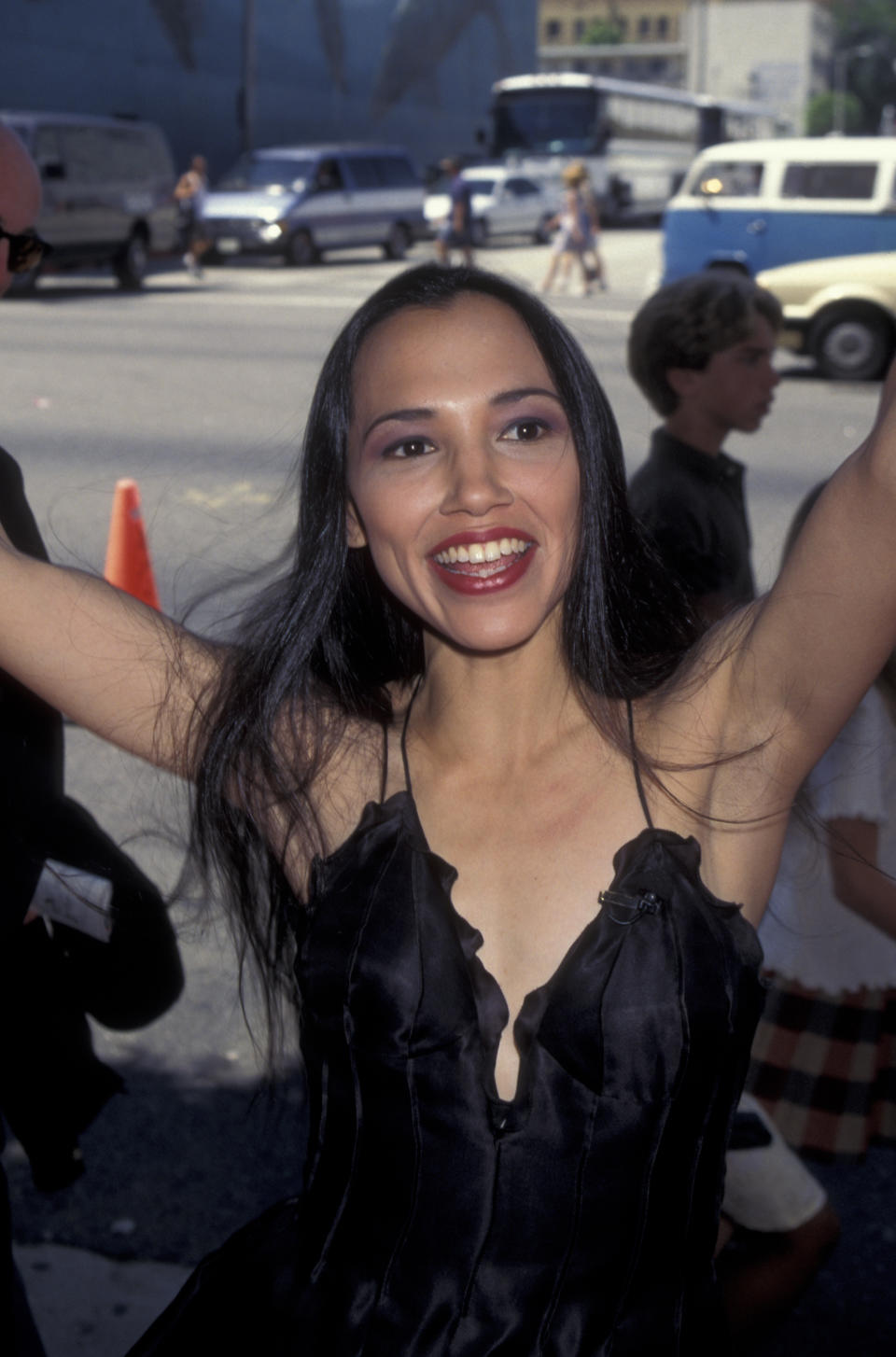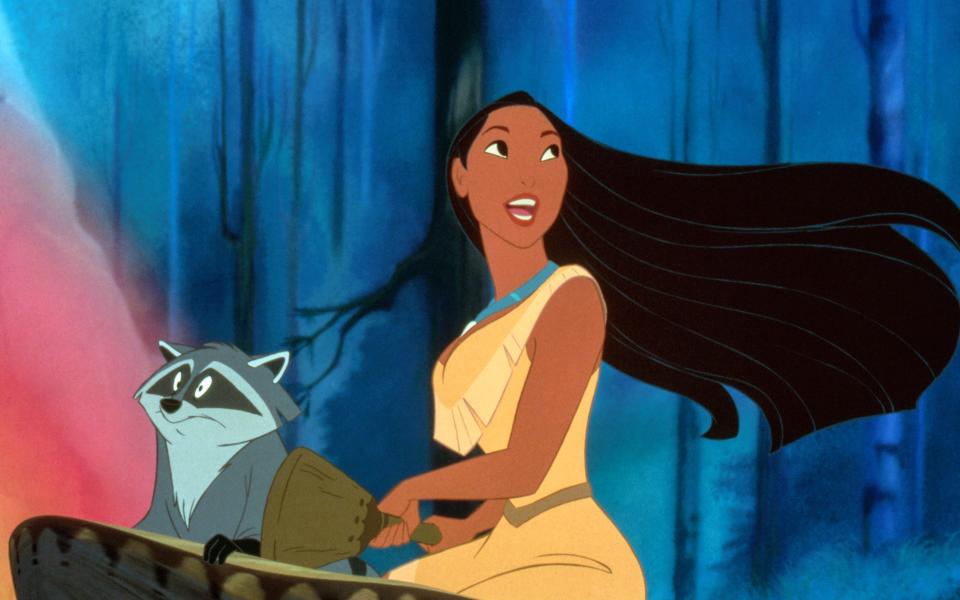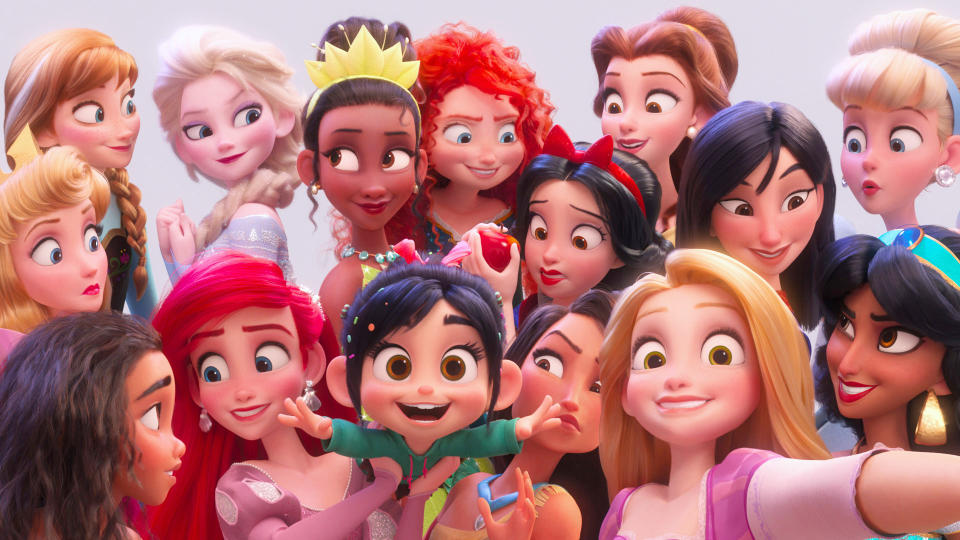'Pocahontas' at 25: Irene Bedard revisits Disney's most controversial song 'Savages'
When Walt Disney’s Pocahontas premiered in cinemas 25 years ago, the movie’s breakout anthem, ‘Colours of the Wind’, quickly became the ‘Let It Go’ of its day.
Written by regular Disney composer, Alan Menken, and lyricist Stephen Schwartz, the song was performed onscreen by Broadway star Judy Kuhn, and recorded by Vanessa Williams in a track that cracked the upper echelons of the Billboard Hot 100. ‘Colours of the Wind’ went on to win the hat trick at the Golden Globes, Grammys and Oscars, and has since been covered by artists ranging from Ashanti to Brian Wilson.
“It’s beautiful and amazing. It’s still amazing to look at those lyrics, which put so much into one song in such a succinct and beautiful way,” Irene Bedard, the voice of Native American peacemaker Pocahontas, tells Yahoo Entertainment. “And Judy just gives a powerhouse of a performance. It’s no wonder that it won the Academy Award.” (Watch our video interview above.)
Read more: Everything coming to Disney+ in June
A quarter-century later, though, there’s another track from Pocahontas that eclipses ‘Colours of the Wind’, at least in terms of timeliness. The climactic song, ‘Savages’, is performed while the Powhatan tribe prepares to defend themselves against the money-minded English settlers led by John Ratcliffe (David Ogden Stiers). As both groups ready to fight, they raise their voices in separate battle cries. “They’re not like you and me, which means they must be evil,” sings Ratcliffe, while Pocahontas’s father, Chief Powhatan (Russell Means), declares: “The paleface is a demon, the only thing they feel at all is greed.”
That us versus them rhetoric — marked by a refusal to see the shared humanity between different races and cultures — echoes on the streets of present-day America, as millions of protestors march to denounce police violence and proclaim that Black lives matter.

“It’s very relevant at this time,” Bedard says of ‘Savages’. Nevertheless, she confesses that the song initially struck a wrong chord with her when Pocahontas was released on June 16, 1995. “When I first saw it, I was like, ‘Why did we have to go there?’” the Alaska-born actress, who is of Inuit and French Canadian Cree heritage, continues. “Why do we have to go that far, that deep into it? It’s so fraught, that word ‘savages.’ So my first instinct was to go, ‘Oh no.’”
Some critics at the time agreed. Washington Post film critic Rita Kempley dismissed ‘Savages’ as “heavy-handed” in her negative review. And in his 1996 essay, The Pocahontas Paradox, indigenous studies professor Cornel Pewewardy explained why he felt the the song was out of place in an animated film aimed at children.
“Despite any possibly well meaning but fundamentally misguided purposes of the Disney screenwriter who wrote the song,” he said, “the fact is that Indian children come home in tears — as they have for centuries — when school children or playmates sing ‘Savages, Savages’ to them. These racial experiences leave deep emotional and psychological scars on young children.”
Bedard says that she wrestled with the legacy of the word “savages” in a one-woman play she wrote years ago. “It was about how all these different characters think of each other as savages in a way,” she recalls adding that she’s since made peace with Pocahontas’s most controversial song. “To see what story it was showing, that both sides were looking at each other in this way of, ‘You’re less than.’ The song really shines a light on that, so ultimately it adds to the story.”
To celebrate the film’s 25th anniversary, Bedard revealed four other things you probably never knew about Pocahontas, from a missing mother to a meeting that has yet to happen.
Bedard still hasn’t met Mel Gibson

Early on in the production process, Disney decided that Pocahontas would take some dramatic liberties with the historical record, including an invented romance between Powhatan’s daughter and English explorer John Smith, voiced by Mel Gibson. (The real Smith was prone to lying about his exploits, and famously told tall tales about the nature of his relationship with Pocahontas.)
The love story was such a crucial part of the movie that directors Mike Gabriel and Eric Goldberg used the first meeting between Pocahontas and Smith as Bedard’s audition scene. “They very much wanted to build everything around that moment,” she recalls, while also pointing out that movie very much embraces legend. “It is not historically accurate: 11 years old was probably the age that Pocahontas was when John Smith came [to America].”

Even as Bedard and Gibson’s cartoon selves acted out this grand romance, the two were never physically in the same place at the same time. In fact, the majority of Bedard’s voiceover sessions were solo over the course of the two-and-a-half year recording process. “I did one voiceover session with Russell, because he wanted to have someone to banter with,” Bedard says. “And I crossed paths with Linda Hunt [who voices Grandmother Willow] as she was going into a session and I was coming out.”
But she and Gibson never saw each other in the recording booth or even outside on the red carpet when the movie premiered. “Mel, at the time, was working on Braveheart, so he wasn’t able to make it to any of the premieres,” Bedard says. “I got to meet everyone at the premiere minus Mel, who I have yet to this day to meet. We did an entire movie together and I have yet to meet him!”
Pocahontas had a mother in early drafts of the script

What’s the deadliest job in the world? Being the mother of a Disney hero or heroine. From Snow White to Elsa and Bambi to Princess Jasmine, the Mouse House is famously quick to get rid of moms. At one point, Pocahontas was going to buck that tragic trend. “There was a mother — I know that Eric and Mike discussed that,” Bedard says.
Ultimately, though, the directors opted to follow the history books, many of which have concluded that Pocahontas’s mother died in childbirth. That choice also opened up some narrative possibilities. “The biggest thing you can do to create anxiety or tension that moves the story forward for children is a missing parent,” Bedard explains, pointing out that Pocahontas’s world in the movie is a lot bigger because of her mother’s absence. “In history, she didn’t have a mother. I think ultimately after getting her father there it felt like it served that. She has the whole village around her.”
Pocahontas was part of an important change for Native American representation on film

In the decades before Pocahontas, Native American representation in Disney’s animated offerings was largely defined by stereotypical characters like Tiger Lily in 1953’s Peter Pan. As a child, Bedard remembers not questioning the sameness of most depictions of indigenous people in television and movies. “I basically am that generation where it sort of shifted from all ‘Cowboys and Indians’ movies where the Indians were the bad guys,” she says. “I even remember at one point having a ‘Cowboys and Indians’ birthday party, and all the kids wanted to be cowboys!”
By the time Bedard embarked on an acting career in the early ‘90s, though, things were starting to change for the better. Movies like Powwow Highway, Dances With Wolves and The Last of the Mohicans offered a canvas for Native American actors to represent their culture and history in ways that hadn’t been seen by mainstream audiences. Bedard’s first starring role was the 1994 made-for-TV movie, Lakota Woman: Siege at Wounded Knee, and she went on to appear in such films as Navajo Blues and Smoke Signals.
With Pocahontas, she made history as the first non-white actress to provide the speaking voice of a Disney Princess. (Aladdin’s Jasmine is officially the first non-white Disney Princess, although her speaking voice was provided by Linda Larkin. Filipina singer, Lea Salonga, provided the character’s singing voice.) “This story was really the very first positive representation of native culture,” Bedard says now. “Respect for the elders, respect for the earth and respect for the animals. Those all were represented in Pocahontas. And out of all the Disney Princesses up until then, she was looking to find her own strength. She doesn’t wait for the prince to come and save her — she saves the prince.”
The Disney Princesses hang out together IRL

Talk about breaking the internet. In 2017, Bedard joined her fellow Disney Princesses at a special D23 reunion promoting their hilarious animated reunion in the hit sequel, Ralph Breaks the Internet. “All of us Disney princesses got presented onstage one at a time, and the crowd was roaring like we were the Beatles,” she says. “That was pretty amazing.”

And the fun didn’t stop when they left the stage. Bedard remembers going on Disneyland’s Guardians of the Galaxy ride with Anika Noni Rose, aka Tiana, and Auliʻi Cravalho, aka Moana, over and over again. She’s also in regular contact with Jodi Benson, Paige O’Hara and Larkin — the alter egos of Ariel, Belle and Jasmine, respectively — for events benefitting charity organisations like Give Kids the World. “It’s probably the best sisterhood on the planet,” she says, happily.
Pocahontas is currently streaming on Disney+.

 Yahoo Movies
Yahoo Movies 

